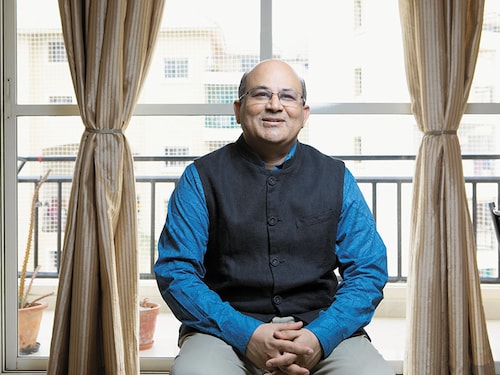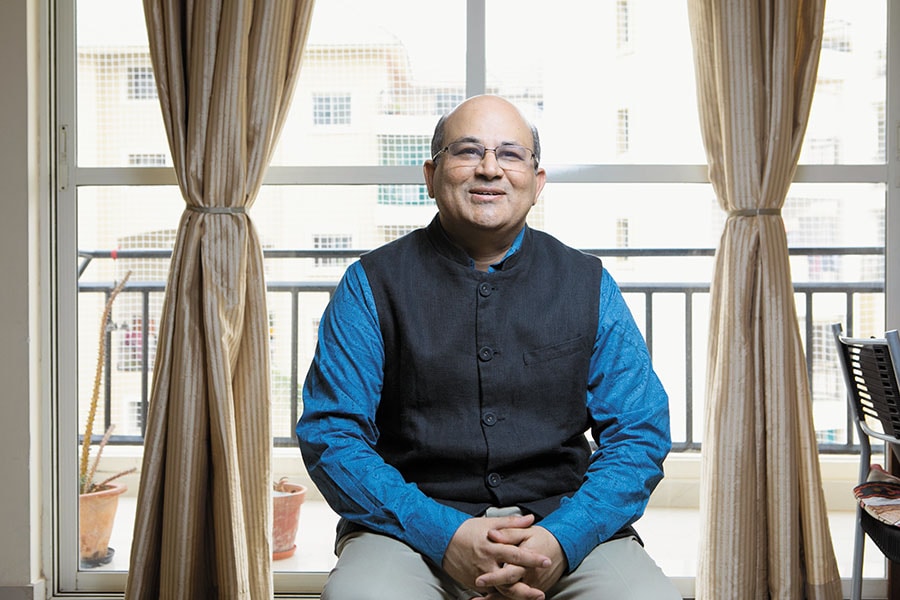Indian companies must capture value: Rishikesha T Krishnan
Copying the rest of the world won't work, India needs its own innovations to prosper, says the director of IIM-Indore and author of From Jugaad to Systematic Innovation


 Rishikesha Krishnan says we missed several technology innovation waves in the past Innovation Nation Image: Selvaprakash Lakshmanan for Forbes India
Rishikesha Krishnan says we missed several technology innovation waves in the past Innovation Nation Image: Selvaprakash Lakshmanan for Forbes India
Q. Give us a bit of historical context for innovation, or the lack of it, in India.
India missed out, by and large, on the industrial revolution. In Europe and the rest of the world, that was when what we might call innovation today started. Since India was under British rule, who didn’t have any real interest in developing industrial activity here, we missed out on that, except in pockets. By the time India became independent, the world had advanced in many directions—fighter aircraft, radar, antibiotics, anti-bacterials and so on.
The first phase of changing this was government-led, to build the country’s science and technology infrastructure, which was largely through government laboratories and the IITs. The ’50s and ’60s was when many of these institutions were created.
After Independence, on the industrialisation front, we were looking mostly at heavy industries, like steel, machine tools, fertilisers, the early days of petroleum refining, etc. As India didn’t have the technologies for these, we decided to import them. The innovation challenge then was very basic—how to adopt and adapt the imported technologies. For instance, the weather conditions and skill sets in the Soviet Union were drastically different from here in India, so a process imported from there needed considerable adaptation. So, for the next two to three decades, the focus was on process and not on product innovation.
From the mid-’80s, there was an interesting turning point, triggered by the entry of Japanese commercial vehicle makers such as Nissan, Mitsubishi and Mazda into the Light Commercial Vehicle (LCV) market. People thought these companies would take over the LCV market in India, but the winner turned out to be Tata Motors, which was called Telco at the time, which decided to develop an LCV that suited Indian conditions, was low cost and easy to maintain. This was the Tata 407 platform, which is still on the road today. This demonstrated that Indian companies could develop products, which may not be cutting edge, but suited to Indian conditions.
The early ’90s brought a bit of a shock for the local industry as liberalisation brought foreign players with superior technology into direct competition with them, and scale became important. This led to a fair number of exits too. Reliance Industries and Tata Steel are examples of those that dug in and survived.
Then software—in services business models—and pharmaceuticals rose to prominence, primarily with process innovation, but also in products to a limited extent. Today, India is closer to the technological frontiers of most industries, but from the point of view of adapting them to Indian conditions with process and business model innovations and only to a limited extent of product innovation.
Q. Why does innovation matter, particularly to India?
One dimension is simply competitiveness, which requires productivity and efficiency. If you have an open economy and external products and services can be brought in, innovation is certainly one important dimension of competitiveness.
Second, it is also about value and how you capture value. For instance, on a $500 mobile phone, Apple makes $350, and Foxconn, which manufactures the phone for Apple, makes $7 or thereabouts. Each business has its own model, but this example helps you focus on the question of ‘who is capturing the value’. Take telecom for example—we have more than a billion mobile phone users, but no local hardware company that is capturing the value here. If you want India to become more prosperous, raise its GDP, then you need more of the value being captured by companies in India.
A third reason is, we have lots of problems and challenges, but we don’t have all the resources to address them. Take health care: The US spends 15-20 percent of its GDP on health care and [still] the results aren’t particularly favourable. Now if India were to replicate the US model, it wouldn’t work even if we spent our entire GDP on it.
However, we would certainly like to provide a high standard of health care to our citizens. How does one create this, within the limitations of resources we face? The answer is innovation. Wherever there are these mega challenges, be it education or skill development, copying the rest of the world won’t work because of the combination of our scale and resource limitations. Innovation holds the key, and it is critical.
Q. Will India miss the bus on the Artificial Intelligence (AI) wave as well?
We have missed several technology innovation waves in the past: We missed the semiconductor wave, by and large, we missed nanotech to a good degree. Even in biotech, we aren’t a major player. The only area we did innovate successfully in on a large scale was software, but again in terms of process and business models and cost-arbitrage and some project management.
Historically, when something is cumulative in nature, it is difficult to catch up. For instance, in the chemistry-based drug industry, for nearly half a century post World War II, there was not a single new significant player at the global level. The existing companies were too well entrenched with their huge investments, libraries of compounds and pipelines of potential new drugs and so on.
It’s only when there is discontinuity, for instance when the industry shifted from chemistry-based to biology-based innovation, a whole set of new companies came up: Genentech, Amgen and so on. When a new technology comes in, no one has an inherent advantage, which presents a window of opportunity to enter that particular segment.
AI and associated technologies—machine learning, deep learning and so on—could be seen in that light. AI was an area that people did some research on in the ’60s and ’70s, but it went out of fashion. It has re-emerged in the last few years. The huge increase in computational power at reasonable costs has helped AI stage a comeback.
India faces the same situation as earlier. Certain countries and companies would like to aggressively take the lead and control the AI story India will have to move fast to establish its own presence.
[qt]By the time india became independent, the world had advanced in many directions. we missed out on the industrial revolution.”[/qt]
Q. What do you make of the nascent Indian startup scene?
A clear assessment is difficult but consider the following points: In terms of the number of startups, with India being the third or fourth biggest base of startups, we can see promising developments. Some of them seem to be looking at India-specific problems and doing a good job.
That said, the same challenges remain. Can our startups pioneer new technology, and cover that with adequate patents and IP protection? How will they compare with startups, say, in Israel or Silicon Valley?
Keeping aside the arguments of local versus foreign, in general, at the early stage, there is a case for government support for startups. What the government is doing with initiatives such as the Atal Innovation Mission and Startup India is certainly good. There is also an attempt to provide funding at the early stage.
One area where the government can really make a difference is in public procurement, by making sure that startups don’t get discriminated against.
The overall ecosystem is developing slowly, but one important change that would make a difference is if more high-end academic research gets converted into commercial applications and ventures.
Q. Can Indian startups build global companies with local innovation?
Various experts have argued that there are multiple Indias in terms of buying power. If you define India’s middle class by global standards, then it is very small. However, if you define it relative to the rest of India, the story changes.
For instance, at $10 a day, which is the Western benchmark, the Indian middle class isn’t so big, but at $3 per day, which could be an Indian definition, there’s a sizeable middle class here. The startups and established companies alike have to figure out what products and services they can profitably offer to such a middle class. The key issue is how sustainable are all these things. Take the example of Uber and Ola. The convenience factor is high, but the other factor that made the real difference was that their prices are much lower than traditional taxi fares. Is this really sustainable? To what extent are the low prices subsidised by venture capital money?
The strikes by Uber and Ola drivers suggest that both companies were looking to find ways of curtailing costs by reducing the incentives that they offered to bring the drivers onto their networks initially. The core question remains: Are the fares at which Ola and Uber operate sustainable? Can a company innovate to genuinely offer a good quality product or service to the $3-a-day type of middle class?
First Published: Apr 30, 2018, 11:36
Subscribe Now